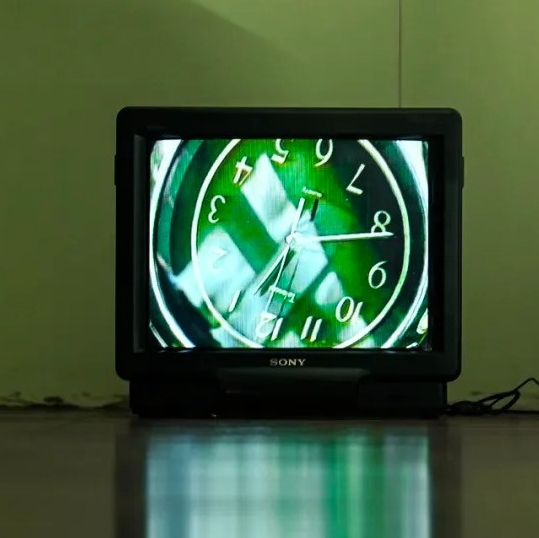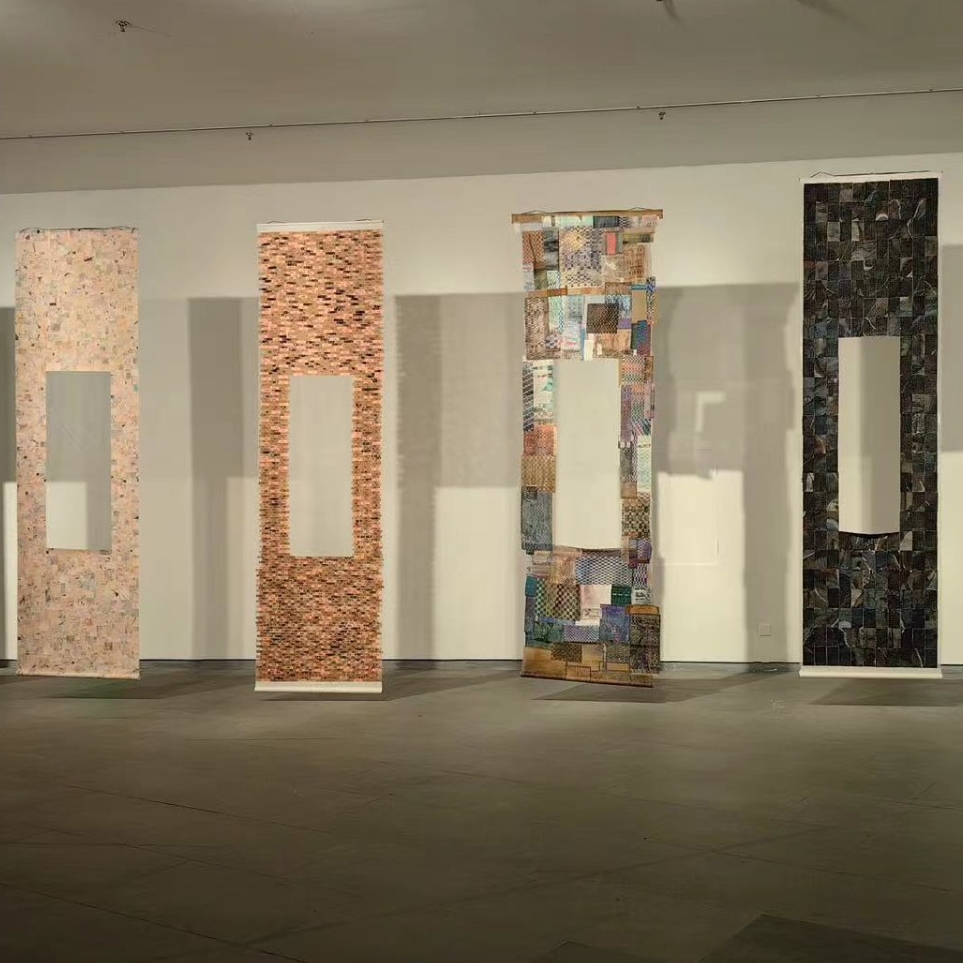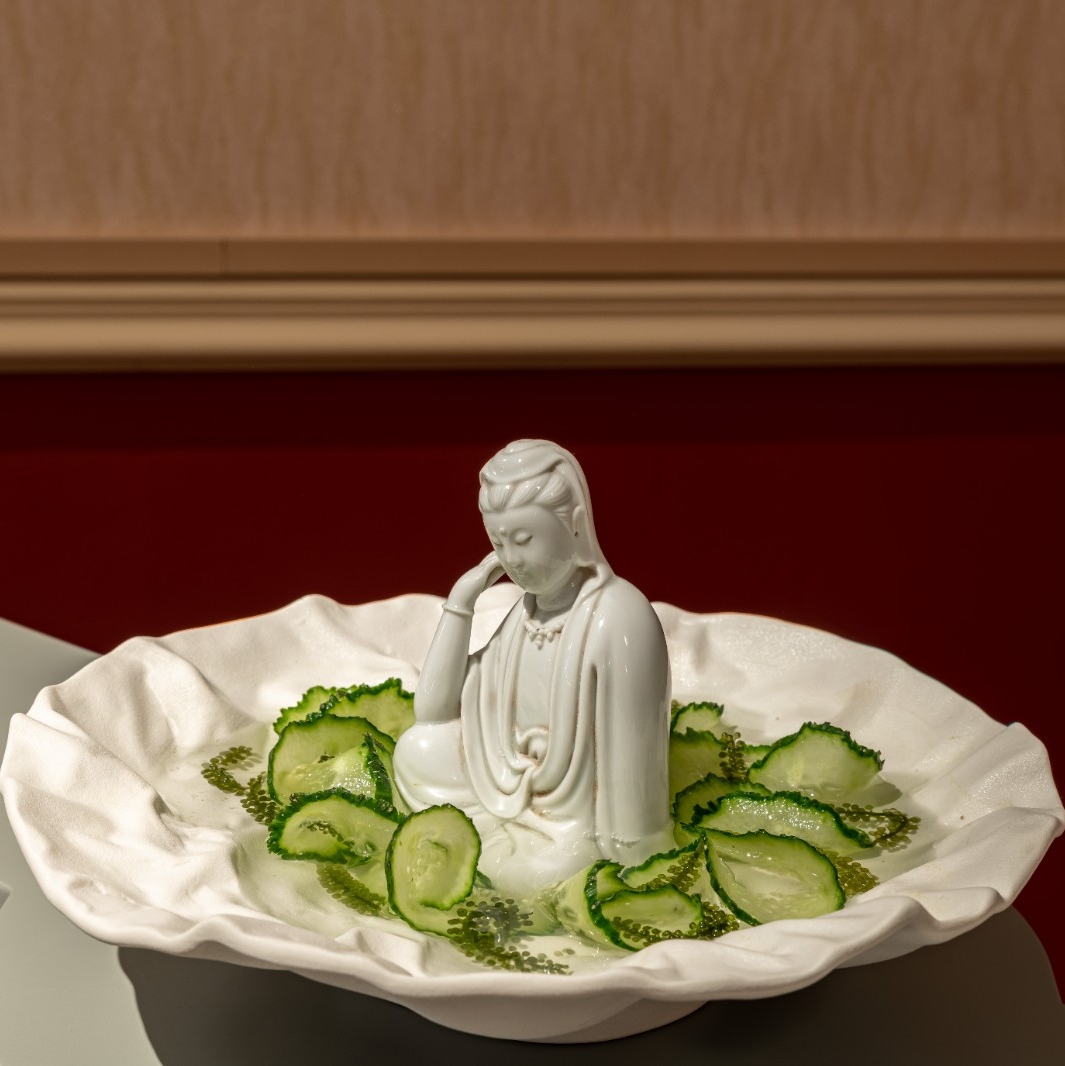
Installation View of "Finding George Orwell in Burma" by Mike Schultz, Photo Courtesy of Chen Tianchan
"Finding George Orwell in Burma" by Mike Schultz is a captivating and aesthetically stunning spatial installation artwork created in 2023. Exhibited at the Installation Gallery of the Institute for Electronic Arts in Alfred, New York, it stands as one of the most enigmatic and visually striking artworks I've encountered in recent memory.
This artwork consists of two integral components: a physical structure and video projections. The physical structure is a wooden framework adorned with an array of items such as crystal balls, ceramic artifacts, wooden objects, and more. The framework, although relatively wide, remains remarkably thin, comprising of four tiers. Placed on the lower-left and lower-right portions of the structure are two ceramic panels resembling fossils. On the left, we find an image of a turtle, while the right side remains somewhat indistinct. The first tier of the framework holds a wooden Oracle alongside various geometric objects crafted from wood, cardboard, or ceramics. These geometric shapes reappear on nearly every tier. Moving to the second tier, the rightmost section houses a crystal ball approximately 5 centimeters in diameter. Adjacent to it stands a wooden coconut tree with paper leaves, accompanied by additional geometric structures. Upon reaching the third tier, one's attention is immediately drawn to a wooden arch-like geometric formation. Within this arch, two ceramic figurines resembling wild beasts can be observed, while a serpent-like ceramic entity graces the structure above. To the left of the arch is an image of a cheetah, painted on paper and rolled into a cylindrical shape. The fourth tier of the framework features a crystal ball on the left side, nearly matching the size of the one on the second tier. Surrounding it are various geometric structures and a ceramic skull.

Installation View of "Finding George Orwell in Burma" by Mike Schultz, Photo Courtesy of Chen Tianchan
The video projection begins with the soothing summer sound of cicadas. Initially, it unveils a dimly lit, bluish painting hanging on the wall, revealing faintly carved human figures on stone. Subsequently, a montage of images flashes by, featuring a patterned mask reminiscent of a Voodoo mask, as well as the ceramic skull mentioned earlier in the physical structure. The book "Finding George Orwell in Burma" by Emma Larkin emerges, and an esoterictic human avatar wearing an owl mask and with the upper body exposed. All this unfolds as the sounds of a train passing through a station chime in, transitioning the imagery to street scenes. The predominantly found-footage style of the video almost convinces the viewer that these are the scenes the artist encountered during their time in Burma.
The visuals continue to shift between scenes seen from an airplane window, sunsets, and nocturnal street views, accompanied by sounds such as local language prayers, wind chimes, airplane noise, and the call of owls in the tropical rainforest. The sequence remains dynamic until it freezes on a fixed scene—a blurry, reddish-toned vision. It appears as if someone is walking through a sunset, surrounded by the chorus of cicadas and birds in the rainforest. The combination of visual blurriness and the clarity of sound immerses the viewer in a moment that feels as if they are seeing the world through the eyes of someone at the verge of death.
This artwork is presented within a dimly lit space, accompanied by a stereo sound system. Throughout the course of the work, the projection's lighting illuminates both the physical structure and the video imagery. The juxtaposition of the video with the nearly monochromatic physical structure transforms what might initially appear as mundane content into a vivid and captivating experience. Furthermore, the shadows cast by the structure onto the projection become an integral and mysterious element of the overall composition. Interestingly, at times, the audience may find themselves more captivated by these cleverly crafted shadows than by the video itself. This interplay between the two mediums, using each other as canvases, creates a multi-dimensional visual effect that transcends the boundaries of conventional art forms. The objects on the structure, which may appear simple and even reminiscent of children's toys, come to life when combined with the accompanying sound and video elements. The dark shadows cast by these objects on the screen transport the audience into a dreamlike realm, evoking a constant sense of déjà vu while they appreciate the artwork.

Installation View of "Finding George Orwell in Burma" by Mike Schultz, Photo Courtesy of Chen Tianchan
"Finding George Orwell in Burma" by Mike Schultz challenges viewers to engage with its multi-layered themes and symbolism, reflecting upon the artist's exploration of history, memory, and the socio-political landscape of contemporary society. One of the central themes of this artwork is the exploration of memory and its role in shaping our perception of history. The physical structure adorned with an assortment of objects serves as a metaphor for the passage of time and the layers of history that accumulate over the years. The ceramic panels resembling fossils and the wooden objects evoke a sense of archaeological discovery, as if the artist is inviting us to unearth hidden narratives and forgotten stories.
The video projection, on the other hand, delves into the artist's personal journey, particularly their experiences in Burma. The choice of imagery, including the owl-masked figure, the Voodoo-like mask, and the book "Finding George Orwell in Burma" by Emma Larkin, alludes to a complex narrative. George Orwell, a renowned author, and political commentator, is known for his writings on totalitarianism and the abuse of power. By incorporating Orwell into the title, the artist may be signaling a connection between the socio-political themes explored in Orwell's works and the contemporary issues faced by Burma and other regions.
The juxtaposition of scenes, sounds, and symbols in the video projection creates a disorienting yet thought-provoking experience. The found-footage style suggests that these images are fragments of the artist's memories, pieced together to form a larger narrative. The owl-masked figure, often associated with wisdom and mystery, could represent the artist's quest for deeper insights into the socio-political landscape of Burma.
Furthermore, the audio elements in the video, including local language prayers, airplane noise, and the sounds of nature, provide a sensory experience that immerses the viewer in the artist's world. This auditory landscape connects the audience to the cultural and environmental aspects of Burma, emphasizing the importance of context in understanding the broader socio-political themes. In the dimly lit space of the installation, the interplay between the physical structure and the video projection is striking. The shadows cast by the objects on the structure become an integral part of the overall composition. This interplay symbolizes the blurred lines between memory and reality, suggesting that our understanding of history is often shaped by our subjective experiences and perceptions.
"Finding George Orwell in Burma" invites viewers to contemplate the intricate web of history, memory, and socio-political forces that shape our world. It serves as a poignant reflection on the enduring relevance of George Orwell's insights into totalitarianism and the ever-evolving socio-political landscape. In an age where the manipulation of information and narratives is prevalent, this artwork prompts us to question the narratives we encounter and seek a deeper understanding of the complex forces at play in our society.
Burma, a nation nestled within the South Asian tropical rainforests with a historical past as a former British colony. However, it has endured the persistent agony of internal conflicts, in the past and up to the present day. Behind the captivating backdrop of lush tropical rainforests lie troubling issues such as human trafficking and the breeding ground for telecommunications fraud, alongside the infamous "Golden Triangle," notorious for its drug trade. This nation, simultaneously beautiful and distorted, harbors an abundance of untold political narratives. Yet, it appears that the artist's intention is not to embark on such a journey. Instead, employing a surrealist approach, the artist compels the audience to immerse themselves in another person's perspective to "experience" this artwork. Throughout the piece, human faces are conspicuously absent. However, whether through the mysterious owl mask, the ceramic skull, or the seamless interplay between urban landscapes and the forces of nature, every element serves as a canvas through which the artist explores the theme of "humanity" with unwavering dedication and inquiry.

Installation View of "Finding George Orwell in Burma" by Mike Schultz, Photo Courtesy of Chen Tianchan
Distinct from many American artists I am familiar with, Mike Schultz exhibits a remarkable patience and sincerity in his artistry. This characteristic may stem significantly from his unique experience of living four years in the mountainous regions of Southeast Asia as a volunteer teacher. This life chapter has not only broadened his perspective but also deepened his sense of humanitarian concern. This background is reflected subtly yet profoundly in his artistic creations. Many of Schultz's earlier works, much like the piece under review, possess a common thread: they often depict scenes devoid of human presence, yet, paradoxically, they seem to engage deeply with human-centric issues. The absence of people in the visual narrative only intensifies the focus on the human condition, subtly provoking the viewer to ponder the invisible human element within the art. Schultz's approach demonstrates his ability to transcend the conventional boundaries of visual storytelling, inviting the audience to engage with the underlying human stories and emotions suggested by the physical and thematic elements of his works.
In the contemporary art landscape, "fast consumption" is an inescapable term. With the prevalence of the internet and concepts like NFTs and the metaverse, artists can have their creations seen by many at an incredibly rapid pace. I've witnessed too many artists producing "artworks" at an almost frenetic speed. While undoubtedly there are dedicated and exceptional artists among them, the vast majority end up getting lost and submerged within the deluge of information they themselves have created. However, Mike Schultz evidently refuses to become one of those artists. His dedication to detail and introspective contemplation infuse his artistic creations, making them remarkably immersive.
In an era where people are fixated on artworks that provide instant, intense stimulation akin to an ice-cold carbonated beverage for the throat, Schultz's art is more like a barrel-aged fine wine crafted from the finest oak—robust yet not overpowering. It's a kind of artisanal art that demands time and experience to fully appreciate its flavor. The ceramic tiger placed on the third tier of the structure seems to be a clue buried deep within our memories, a silhouette that may suddenly come into view one day in the future. This reminds me of when I, at the age of three, held a toy tiger in my hand and imagined it roaring. Nothing changed until over two decades later, when the weariness of adulthood's rules and responsibilities left me feeling utterly drained. I suddenly felt a gust of wind at my back, sensing something amiss. I swiftly turned around, and with a roar, a tiger's claw came upon me, tearing apart the last remnants of innocence in my soul.
When everyone is eager to press that button to seek quick solutions or shortcuts through technology, Schultz's art concentrates more on posing questions or the process of the questioning. This work involves a broad spectrum of mediums, with the physical components requiring extensive time for construction, including the time-consuming process of firing ceramics. The dedication to art itself is evident in the artist's arrangement, a dedication that transcends any single piece of his work, much like how discussions about Van Gogh often center more on his life experiences and commitment to art.
However, this poses a significant challenge for Mike Schultz. An excessive fixation on the question and an overly perfectionist approach to art create an 'autonomous' environment in his work. The setup of the installations makes it nearly impossible for viewers to engage in a 'face-to-face' interaction with the art. We are relegated to appreciating the entirety from a distance or a side view, unable to converse with the spatial installation. This envelops me in a constant sense of dissatisfaction, though perhaps the artist is indifferent to this, or even intentionally constructs this 'Eden' to make us aware of his creation.
About the author and artist

Chen Tianchan is a dedicated and passionate artist with 10 years of academic experience in mathematics, programming, and artificial intelligence. He graduated from the Machine Learning Program at the Schwarzman Computer College, Massachusetts Institute of Technology(MIT).
With the education background of Master of Arts degree from Alfred University, Bachelor of Mathematics from New York University and the University of Wollongong, his artwork demonstrates profound foresight and rational beauty, rapidly spreading worldwide.
Between 2019 and 2021, as a member of Beijing ElightV Technology Co., Ltd., Tianchan Chen participated in the research and development of XR technology software and the implementation of art market expansion. He possesses exceptional skills in text translation, cross-cultural communication, brand management, and data analysis, exhibiting outstanding abilities in academic presentations within the realms of art and technology.
Courtesy of Chen Tianchan.




























